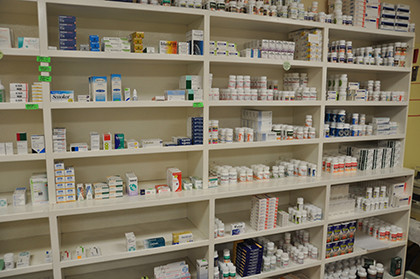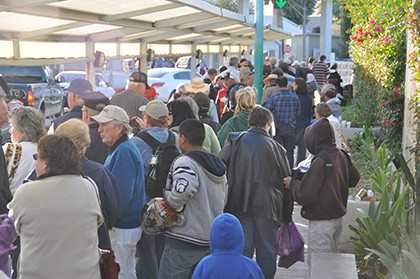Looking to purchase antibiotics in Mexico? At gaymexico.net, we understand that accessing healthcare while traveling, especially for the LGBTQ+ community, can be a concern. This comprehensive guide answers your questions about obtaining antibiotics in Mexico, ensuring a safe and informed experience. You’ll find information on prescription requirements, popular medications, legal considerations, and tips for a smooth trip. Prepare for your travels with confidence, knowing you have the resources to navigate healthcare in Mexico with ease.
1. Is It Possible To Obtain Antibiotics In Mexico?
Yes, obtaining antibiotics in Mexico is generally possible, but regulations have become stricter in recent years. While it used to be common to purchase many medications, including antibiotics, over the counter, it’s now increasingly required to have a prescription from a licensed Mexican doctor. This change aims to combat antibiotic resistance and ensure responsible medication use. For LGBTQ+ travelers, understanding these regulations is crucial for planning and accessing necessary healthcare during their visit.
Considerations When Acquiring Antibiotics In Mexico
- Prescription Requirements: While some pharmacies may still offer certain antibiotics without a prescription, it’s highly recommended to obtain one from a Mexican doctor to avoid any potential issues.
- Types of Antibiotics Available: Common antibiotics like amoxicillin, ciprofloxacin, and azithromycin are generally available, but the specific availability may vary by pharmacy and region.
- Cost of Antibiotics: Antibiotics in Mexico are typically more affordable than in the United States or Canada, making it an attractive option for those without comprehensive insurance coverage.
- Pharmacy Options: Numerous pharmacies can be found in tourist areas and major cities, ranging from large chain pharmacies to smaller, independent drugstores.
- Language Barrier: While many pharmacies in tourist areas have English-speaking staff, it’s helpful to know basic Spanish phrases or use a translation app to communicate your needs effectively.
2. What Are The Current Regulations For Buying Antibiotics In Mexico?
The current regulations for buying antibiotics in Mexico require a prescription from a licensed Mexican doctor. In recent years, the Mexican government has implemented stricter rules to combat antibiotic resistance, aligning with global health recommendations. This means that over-the-counter sales of antibiotics are now less common, and pharmacies are more likely to require proof of prescription before dispensing these medications. These rules apply to both residents and tourists, including LGBTQ+ travelers, who need to be aware of these changes to ensure they can access necessary medications legally and safely.
Understanding The Specifics Of The Regulations
- Enforcement: The enforcement of these regulations can vary by region and pharmacy, but it’s becoming increasingly strict across Mexico.
- Prescription Validity: A prescription from a doctor outside of Mexico may not be accepted. It’s advisable to consult with a local Mexican doctor to obtain a valid prescription.
- Quantity Limits: There may be limits on the quantity of antibiotics that can be purchased, typically aligned with the prescribed dosage and treatment duration.
- Types of Antibiotics Affected: The regulations generally apply to all types of antibiotics, including those commonly used to treat bacterial infections.
- Penalties for Non-Compliance: Purchasing or possessing antibiotics without a valid prescription can result in fines or confiscation of the medication.
3. How Can I Obtain A Prescription For Antibiotics In Mexico?
Obtaining a prescription for antibiotics in Mexico is relatively straightforward. One of the easiest ways is to visit a local doctor or clinic. Many pharmacies also have on-site doctors who can provide a consultation and write a prescription if necessary. Telemedicine services are also becoming increasingly popular, allowing you to consult with a doctor remotely and receive a prescription online. For LGBTQ+ travelers, knowing how to access these medical services ensures they can address health concerns promptly and legally while in Mexico.
Steps To Secure Your Prescription
- Find a Doctor or Clinic: Search online for reputable doctors or clinics in the area you are visiting. Websites like gaymexico.net can provide recommendations for LGBTQ+-friendly healthcare providers.
- Schedule an Appointment: Contact the doctor or clinic to schedule an appointment. Some clinics offer walk-in services, but making an appointment can save time.
- Consultation: During the consultation, explain your symptoms and medical history to the doctor. Be prepared to answer questions about your current health condition and any medications you are currently taking.
- Receive Prescription: If the doctor determines that antibiotics are necessary, they will write a prescription. Ensure that the prescription includes the name of the medication, dosage, and duration of treatment.
- Fill Prescription at Pharmacy: Take the prescription to a local pharmacy to fill it. Pharmacies in Mexico are generally well-stocked, and you should be able to find the prescribed antibiotic.
4. What Are Some Common Antibiotics Available In Mexico?
Several common antibiotics are readily available in Mexico, often at lower prices than in the United States or Canada. These include amoxicillin, ciprofloxacin, azithromycin, and doxycycline, among others. These antibiotics are used to treat a variety of bacterial infections, such as respiratory infections, urinary tract infections, and skin infections. For LGBTQ+ travelers, knowing the types of antibiotics available can help them communicate their needs to healthcare providers and ensure they receive appropriate treatment while in Mexico.
Common Antibiotics Available in Mexico:
| Antibiotic | Common Uses | Form |
|---|---|---|
| Amoxicillin | Respiratory infections, ear infections, urinary tract infections | Capsules, tablets, oral suspension |
| Ciprofloxacin | Urinary tract infections, respiratory infections, skin infections | Tablets, oral suspension |
| Azithromycin | Respiratory infections, skin infections, sexually transmitted infections | Tablets, oral suspension |
| Doxycycline | Respiratory infections, skin infections, Lyme disease | Capsules, tablets |
| Cephalexin | Skin infections, respiratory infections, urinary tract infections | Capsules, tablets, oral suspension |
| Metronidazole | Bacterial and parasitic infections | Tablets, capsules, intravenous solution |
| Trimethoprim/ | Urinary tract infections | Tablets |
| Sulfamethoxazole |
 Antibiotics in Mexico
Antibiotics in Mexico
Important Considerations:
- Brand Names: Be aware that brand names for antibiotics may differ in Mexico compared to other countries.
- Generic Options: Generic versions of many antibiotics are available, which can be more affordable.
- Dosage: Always follow the dosage instructions provided by the doctor or pharmacist.
- Side Effects: Be aware of potential side effects and consult with a healthcare provider if you experience any adverse reactions.
5. Are There Any Restrictions On Bringing Antibiotics Back To The US From Mexico?
Yes, there are restrictions on bringing antibiotics back to the US from Mexico. According to the U.S. Food and Drug Administration (FDA), individuals are generally allowed to bring a 90-day supply of medication for personal use. However, the medication must be accompanied by a valid prescription from a licensed US doctor. If you don’t have a US prescription, you can still bring back a small quantity, typically considered a personal use amount, but it’s subject to the discretion of the Customs and Border Protection (CBP) officer. For LGBTQ+ travelers, understanding these regulations is crucial to avoid potential issues when returning to the US with necessary medications.
Understanding The FDA Guidelines:
- Personal Use: The FDA allows the import of medications for personal use, which typically means a 90-day supply.
- Prescription Requirement: Ideally, you should have a valid prescription from a US-licensed doctor for any medication you bring back.
- Declaration: You must declare all medications you are bringing into the US to the CBP officer at the border.
- Original Packaging: Keep the medication in its original packaging with the prescription label if possible.
- Controlled Substances: Certain medications considered controlled substances have stricter regulations and may not be allowed across the border without proper documentation.
6. What Should I Do If I Run Out Of Antibiotics While In Mexico?
If you run out of antibiotics while in Mexico, the best course of action is to consult with a local doctor to obtain a new prescription. Many pharmacies in Mexico have on-site doctors who can provide a consultation and write a prescription if necessary. Telemedicine services are also a convenient option, allowing you to consult with a doctor remotely and receive a prescription online. For LGBTQ+ travelers, knowing these options ensures they can promptly address their healthcare needs and continue their treatment without interruption.
Steps to Take When You Run Out of Antibiotics:
- Consult a Local Doctor: Find a reputable doctor or clinic in the area you are visiting. Websites like gaymexico.net can provide recommendations for LGBTQ+-friendly healthcare providers.
- Telemedicine Services: Consider using telemedicine services, which allow you to consult with a doctor remotely and receive a prescription online.
- Pharmacy Consultation: Some pharmacies have on-site doctors who can provide a consultation and write a prescription.
- Explain Your Situation: When consulting with the doctor, explain that you ran out of your medication and provide details about your current treatment and medical history.
- Obtain a New Prescription: If the doctor determines that antibiotics are necessary, they will write a new prescription.
- Fill the Prescription: Take the new prescription to a local pharmacy to fill it.
7. Are Antibiotics Cheaper In Mexico Compared To The US?
Yes, antibiotics are generally cheaper in Mexico compared to the US. The cost of prescription medications, including antibiotics, is often significantly lower due to factors such as lower manufacturing costs, less stringent regulations, and different pricing structures. This can make Mexico an attractive option for individuals seeking affordable healthcare, particularly those without comprehensive insurance coverage. For LGBTQ+ travelers, this can be a significant benefit, allowing them to access necessary medications at a more reasonable cost.
Factors Contributing to Lower Costs:
- Manufacturing Costs: Lower manufacturing costs in Mexico contribute to the overall lower prices of medications.
- Less Stringent Regulations: Mexico’s pharmaceutical regulations are often less stringent than those in the US, which can reduce costs.
- Pricing Structures: Different pricing structures and negotiations between pharmaceutical companies and the government can result in lower prices for consumers.
- Generic Options: Generic versions of many antibiotics are readily available in Mexico, which are typically more affordable than brand-name medications.
- Competition: The presence of numerous pharmacies and competitive pricing can also drive down the cost of antibiotics.
8. What Are The Potential Risks Of Buying Antibiotics Without A Prescription In Mexico?
Buying antibiotics without a prescription in Mexico carries several potential risks. One of the primary concerns is the misuse and overuse of antibiotics, which can contribute to antibiotic resistance. Taking antibiotics unnecessarily or without proper medical guidance can lead to bacteria becoming resistant to the medication, making future infections harder to treat. Additionally, obtaining antibiotics from unregulated sources can expose you to counterfeit or substandard medications, which may be ineffective or harmful. For LGBTQ+ travelers, understanding these risks is essential to making informed decisions about their healthcare and ensuring their safety while in Mexico.
Potential Risks of Buying Antibiotics Without a Prescription:
- Antibiotic Resistance: Unnecessary use of antibiotics contributes to the development of antibiotic-resistant bacteria.
- Misdiagnosis: Without a proper diagnosis from a doctor, you may be taking the wrong antibiotic for your condition.
- Incorrect Dosage: Taking the wrong dosage of antibiotics can be ineffective or harmful.
- Adverse Reactions: Without medical supervision, you may not be aware of potential side effects or allergic reactions to the medication.
- Counterfeit Medications: Purchasing antibiotics from unregulated sources can expose you to counterfeit or substandard medications.
- Delayed Treatment: Self-treating with antibiotics can delay proper medical care and potentially worsen your condition.
9. Are There LGBTQ+-Friendly Healthcare Providers In Mexico That I Can Consult?
Yes, there are LGBTQ+-friendly healthcare providers in Mexico that you can consult. Mexico City, Puerto Vallarta, and other major tourist destinations have doctors and clinics that are welcoming and sensitive to the needs of LGBTQ+ individuals. These healthcare providers can offer a safe and supportive environment for discussing health concerns and receiving appropriate medical care. Resources like gaymexico.net can help you find recommended LGBTQ+-friendly healthcare providers in various locations across Mexico.
Tips for Finding LGBTQ+-Friendly Healthcare Providers:
- Online Research: Use online search engines and LGBTQ+-specific directories to find healthcare providers who advertise as LGBTQ+-friendly.
- Recommendations: Ask for recommendations from LGBTQ+ community organizations, friends, or other travelers who have visited Mexico.
- Check Reviews: Read online reviews and testimonials to get an idea of other people’s experiences with the healthcare provider.
- Contact the Provider: Call or email the healthcare provider to inquire about their experience with LGBTQ+ patients and their commitment to providing inclusive care.
- Visit LGBTQ+ Community Centers: LGBTQ+ community centers in Mexico can often provide referrals to LGBTQ+-friendly healthcare providers.
10. What Are Some Tips For Staying Healthy While Traveling In Mexico?
Staying healthy while traveling in Mexico involves taking several precautions to protect yourself from illness and injury. These include practicing good hygiene, being mindful of food and water safety, protecting yourself from mosquito bites, and being aware of potential health risks in the areas you are visiting. For LGBTQ+ travelers, these tips are particularly important to ensure a safe and enjoyable trip.
Essential Tips for Staying Healthy in Mexico:
- Practice Good Hygiene: Wash your hands frequently with soap and water, especially before eating and after using the restroom.
- Drink Bottled Water: Avoid drinking tap water, which may not be safe. Stick to bottled water or water that has been properly boiled or treated.
- Be Mindful of Food Safety: Eat at reputable restaurants and avoid street food that may not be properly prepared or stored.
- Protect Yourself from Mosquito Bites: Use insect repellent containing DEET, wear long sleeves and pants, and stay in accommodations with mosquito screens or air conditioning.
- Get Vaccinations: Consult with your doctor about recommended vaccinations for Mexico, such as hepatitis A, typhoid, and tetanus.
- Travel Insurance: Purchase travel insurance that covers medical expenses, including emergency evacuation.
- Sun Protection: Protect yourself from the sun by wearing sunscreen, a hat, and sunglasses.
- Stay Hydrated: Drink plenty of fluids to stay hydrated, especially in hot weather.
- Be Aware of Altitude Sickness: If you are traveling to high-altitude areas, take precautions to prevent altitude sickness, such as avoiding strenuous activity and drinking plenty of water.
 Travel to Los Algodones for discount meds and Mexico dental
Travel to Los Algodones for discount meds and Mexico dental
FAQ About Obtaining Antibiotics In Mexico
1. Can I purchase antibiotics over the counter in Mexico?
While it was previously common, current regulations increasingly require a prescription from a licensed Mexican doctor to purchase antibiotics. Some pharmacies may still offer certain antibiotics without a prescription, but it’s best to obtain one to avoid issues.
2. What types of antibiotics are readily available in Mexico?
Common antibiotics like amoxicillin, ciprofloxacin, azithromycin, and doxycycline are generally available in Mexico. However, specific availability can vary by pharmacy and region.
3. Is a prescription from my home country valid in Mexico?
Generally, a prescription from a doctor outside of Mexico is not accepted. It’s advisable to consult with a local Mexican doctor to obtain a valid prescription.
4. What should I do if I need antibiotics but don’t have a prescription?
Visit a local doctor or clinic in Mexico to obtain a prescription. Many pharmacies also have on-site doctors who can provide a consultation and write a prescription if necessary.
5. Are antibiotics cheaper in Mexico compared to the US?
Yes, antibiotics are typically more affordable in Mexico due to lower manufacturing costs and different pricing structures.
6. Can I bring antibiotics back to the US from Mexico?
You can usually bring a 90-day supply of medication for personal use with a valid prescription from a US doctor. Without a US prescription, you can bring back a small quantity, but it’s subject to CBP officer discretion.
7. What are the risks of buying antibiotics without a prescription?
Risks include contributing to antibiotic resistance, misdiagnosis, incorrect dosage, adverse reactions, and exposure to counterfeit medications.
8. How can I find LGBTQ+-friendly healthcare providers in Mexico?
Use online search engines, LGBTQ+-specific directories, and community recommendations to find healthcare providers who are welcoming and sensitive to LGBTQ+ individuals.
9. Are there any specific health concerns I should be aware of as an LGBTQ+ traveler in Mexico?
Be aware of potential health risks in the areas you are visiting, practice good hygiene, be mindful of food and water safety, and protect yourself from mosquito bites.
10. What if I run out of my prescription antibiotics while traveling in Mexico?
Consult with a local doctor or use telemedicine services to obtain a new prescription. Many pharmacies also have on-site doctors who can help.
Remember to explore gaymexico.net for more comprehensive travel guides, event listings, and community connections to make your trip to Mexico safe, enjoyable, and unforgettable. For assistance, you can contact us at Address: 3255 Wilshire Blvd, Los Angeles, CA 90010, United States. Phone: +1 (213) 380-2177.

